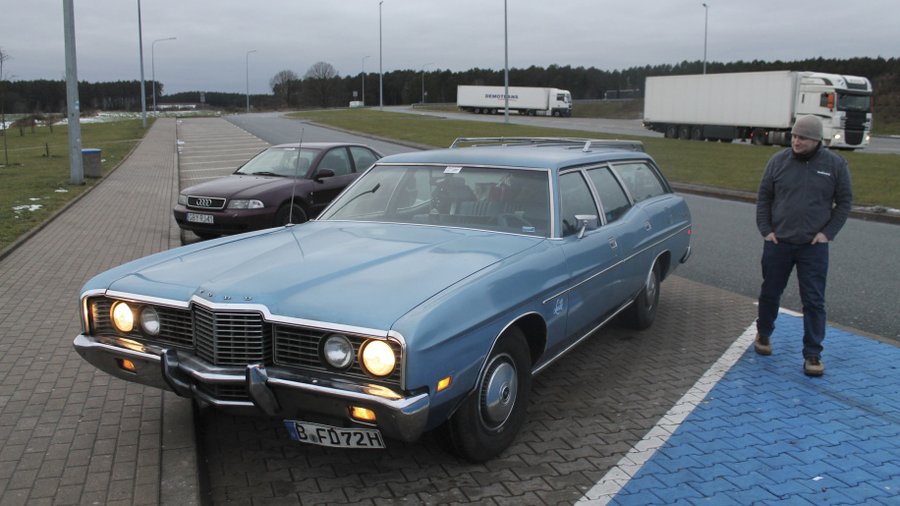Driving a 1972 Ford station wagon from Berlin to a Finnish ice-racing course

The other part had to do with an ice track weekend in Northern Finland, and a daily-driven 1972 Ford Country Sedan – 219 inches of blue station wagon imported to Germany from Ohio, affectionately called Lucille after her original owner. We were going to drive it all the way north, expensive gas and everything. How does 1,450 miles in one go sound?
We were cautiously hopeful there would be no technical maladies, as during the past weeks the car had received a host of improvements. Lucille's owner had bolted on a brand new X-pipe exhaust setup with Hooker headers, making the big Cleveland with its Edelbrock Performer cam rumble and roar like a rude and happy beast. On Wednesday, we packed the wagon with necessary supplies, and our four-person crew headed out of town towards Warsaw. The plan was to drive all night long, until we would finally reach the ferry harbor in Tallinn before Thursday noon, then sleep on the ferry for a couple hours and again continue north.
The trip started out smooth, with the autobahn dry, the ride comfortable, and the jokes bad. The engine upgrades, especially the Holley Sniper EFI, returned roughly 13.5 mpg – not bad at all from that 400 cubic inch engine! By European standards, that's incredibly thirsty, so we'd be stopping every 200-250 miles to buy some more of that reasonably-priced Eastern European fuel and swap drivers, giving our crew members a good chance to get some sleep in the comfy back seat after each one of us had completed their stint.
I took the helm somewhere between Poznań and Łódź after sunset, enjoying the effortless power the 400-2V offered. Lucille cruised perfectly at 80 mph, but even brand new steering bits didn't prepare me for the floaty handling which took some time to adjust. In daylight and with a grippier road surface the waftiness wouldn't have mattered much, but we knew the temperature was soon dropping close to freezing. Lucille was wearing all-season tires, and although they were pretty good Toyos, we were praying that we wouldn't have to subject her to any emergency moose test maneuvers. The road north was largely fine in Poland until a little past Warsaw, where road construction forced us onto narrow, sketchy side roads. But once we arrived in Lithuania amidst thick fog, the local roads gave us an unwelcome surprise.
With Philipp, Lucille's owner behind the wheel at 4AM, Lucille hit an invisible speed bump at 35 mph, and the rear end slammed into the road surface. This caused the EFI setup's high-pressure fuel pump, housed in a sturdy and sharp-edged casing, to slam into the gas tank, puncturing it. After detecting a strong fuel smell from the raw gas gushing out, we sensibly pulled over immediately to assess the damage. It took us a long time to figure out whether we could finish the journey at all, and it seemed like Lucille would be stranded in frigid Lithuania.
Luckily, the garage our tow truck took us to in the wee hours of the morning was able to plug the puncture with epoxy. This was after the mechanics had spent an hour laughing about our innocent idea of welding the damaged tank. "Benzinas, BOOM!", they kept repeating.
After some much-needed sleep on the garage sofa and a good breakfast nearby, we were able to leave Panevėžys and continue north towards Estonia through Latvia, with the 400 again rumbling happily with fuel in its guts. We didn't make the ferry we had originally booked, but luckily I had been able to transfer the booking. We arrived in Helsinki late Thursday night, and retreated to sleep in real beds instead of a mechanic's couch. In the morning, the fuel tank repairs were inspected at another garage. The epoxy patch would hold up, for now.
The weather on Finnish roads proved challenging – a semi truck had skid off the road and caused a traffic jam on Highway 4 that connects the ends of the country. Soon, we wished for a proper winter tire set as the roads north were completely iced over – but luckily, no wild animals like moose or deer jumped ahead of us, and emergency braking wasn't necessary. In the late hours of Friday evening we made it to the airfield our 30-strong group of gearheads had booked, 435 miles from Helsinki and about 100 miles from the Arctic Circle, and I was ready to start sautéing some frozen reindeer. And hit the sauna, of course.
On the high-banked ice tracks, it was best to keep Lucille's speeds low and proceed with extreme caution. Much of the trim and bumper metal would be unobtainable by now, and the $350 ice track beaters that our British friends had acquired for driver training and related shenanigans gained a significant amount of damage during the weekend. That is a story unto itself, and it resulted in a half a dozen of UK-registered and hilariously decorated cars dumped unceremoniously at a Lapland junkyard. But at least we all learned something.
The Berlin crew parted ways in a burger bar in Oulu, Finland, and by midday on Tuesday, Lucille had made it back to its home neighborhood via the straight, safe roads of Sweden. On the tour around the Baltic Sea, the car drank 211 gallons of fuel over 2,850 miles. It served its occupants well, and the only issue by the end of the drive was a propshaft U-joint developing a vibration.
Driving an early 1970s American station wagon through Baltic and Nordic winter nights is exactly the sort of crazy idea that might just work – and with a good crew, coffee and service station food it's definitely manageable. But bring some Lapland-proof tires if you want to have a go.
Related News
